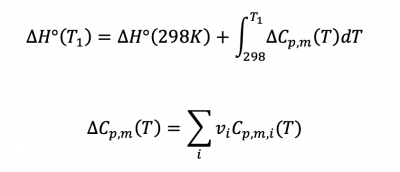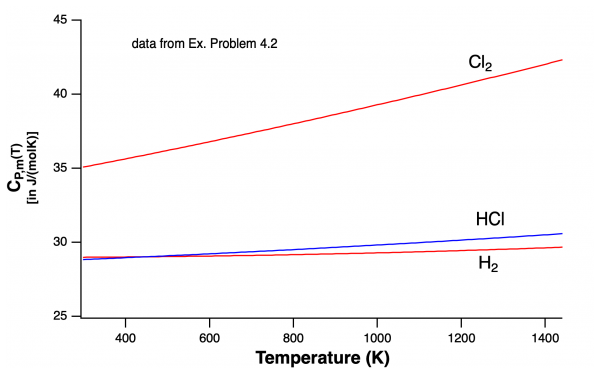Difference between revisions of "PChem312 f20 w11"
Jump to navigation
Jump to search
| Line 16: | Line 16: | ||
Study Example Problem 4.2 for calculation details... | Study Example Problem 4.2 for calculation details... | ||
:ΔH°(298K) = -92.3 kJ/mol HCl | :ΔH°(298K) = -92.3 kJ/mol HCl | ||
| − | : temp correction = -2.8 kJ/mol HCl (''mainly due to the change in the heat capacity of Cl<sub>2</sub> gas.'' | + | : temp correction = -2.8 kJ/mol HCl |
| + | :ΔH°(298K) = -95.1 kJ/mol HCl | ||
| + | :'''''Explanation: this difference is mainly due to the change in the heat capacity of Cl<sub>2</sub> gas; the product HCl has a lower heat capacity than Cl<sub>2</sub>...so heat produced from the reaction cannot be contained in the products hence it is given off...ie. higher ΔH°(1450K).''''' | ||
:[[File:ExProb4_2.png|600px]] | :[[File:ExProb4_2.png|600px]] | ||
Revision as of 14:37, 26 October 2020
Monday, Oct 26, 2020
Announcement: Exam 2, Thursday, Oct 29th (Ch 3 and 4)
Sec 4.4
Temperature dependence of reaction enthalpies...
This problem involves 2 parts:
- 1) ΔH°(298K) can be calculated via heats of formation (ΔH°f)
- 2) the second part requires that you look up the Cp,m values from table 2.5...
Study Example Problem 4.2 for calculation details...
- ΔH°(298K) = -92.3 kJ/mol HCl
- temp correction = -2.8 kJ/mol HCl
- ΔH°(298K) = -95.1 kJ/mol HCl
- Explanation: this difference is mainly due to the change in the heat capacity of Cl2 gas; the product HCl has a lower heat capacity than Cl2...so heat produced from the reaction cannot be contained in the products hence it is given off...ie. higher ΔH°(1450K).
Weds, Oct 28, 2020
- DCS?
Thurs, Oct 29th, 2020
- Exam 2, Ch 3 and 4.
Friday, Oct 30th, 2020
- no class

